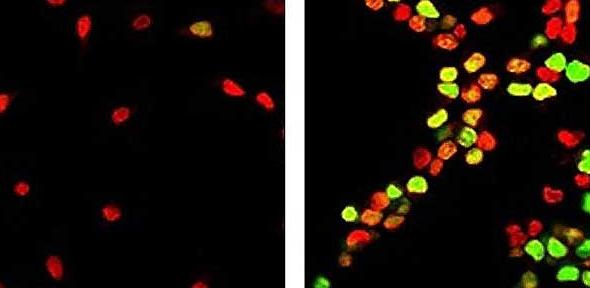
The results, published today in Nature, have far-reaching implications for how we understand the ageing process, and how we might develop much-needed treatments for age-related brain diseases.
As our bodies age, our muscles and joints can become stiff, making everyday movements more difficult. This study shows the same is true in our brains, and that age-related brain stiffening has a significant impact on the function of brain stem cells.
A multi-disciplinary research team, based at the Wellcome-MRC Cambridge Stem Cell Institute at the University of Cambridge, studied young and old rat brains to understand the impact of age-related brain stiffening on the function of oligodendrocyte progenitor cells (OPCs). These cells are a type of brain stem cell important for maintaining normal brain function, and for the regeneration of myelin – the fatty sheath that surrounds our nerves, which is damaged in multiple sclerosis (MS). The effects of age on these cells contributes to MS, but their function also declines with age in healthy people.
To determine whether the loss of function in aged OPCs was reversible, the researchers transplanted older OPCs from aged rats into the soft, spongy brains of younger animals. Remarkably, the older brain cells were rejuvenated, and began to behave like the younger, more vigorous cells.
To study this further, the researchers developed new materials in the lab with varying degrees of stiffness, and used these to grow and study the rat brain stem cells in a controlled environment. The materials were engineered to have a similar softness to either young or old brains.
To fully understand how brain softness and stiffness influences cell behavior, the researchers investigated Piezo1 – a protein found on the cell surface, which informs the cell whether the surrounding environment is soft or stiff.
Dr Kevin Chalut, who co-led the research, said: “We were fascinated to see that when we grew young, functioning rat brain stem cells on the stiff material, the cells became dysfunctional and lost their ability to regenerate, and in fact began to function like aged cells. What was especially interesting, however, was that when the old brain cells were grown on the soft material, they began to function like young cells – in other words, they were rejuvenated.”
“When we removed Piezo1 from the surface of aged brain stem cells, we were able to trick the cells into perceiving a soft surrounding environment, even when they were growing on the stiff material,” explained Professor Robin Franklin, who co-led the research with Dr Chalut. “What’s more, we were able to delete Piezo1 in the OPCs within the aged rat brains, which lead to the cells becoming rejuvenated and once again able to assume their normal regenerative function.”
Dr Susan Kohlhaas, Director of Research at the MS Society, who part funded the research, said: “MS is relentless, painful, and disabling, and treatments that can slow and prevent the accumulation of disability over time are desperately needed. The Cambridge team’s discoveries on how brain stem cells age and how this process might be reversed have important implications for future treatment, because it gives us a new target to address issues associated with aging and MS, including how to potentially regain lost function in the brain.”
This research was supported by the European Research Council, MS Society, Biotechnology and Biological Sciences Research Council, The Adelson Medical Research Foundation, Medical Research Council and Wellcome.
Niche stiffness underlies the ageing of central nervous system progenitor cells, M. Segel, B. Neumann, M. Hill, I. Weber, C. Viscomi, C. Zhao, A. Young, C. Agley, A. Thompson, G. Gonzalez, A. Sharma, S. Holmqvist, D. Rowitch, K. Franze, R. Franklin and K. Chalut is published in Nature.
New research reveals how increasing brain stiffness as we age causes brain stem cell dysfunction, and demonstrates new ways to reverse older stem cells to a younger, healthier state.

The text in this work is licensed under a Creative Commons Attribution 4.0 International License. Images, including our videos, are Copyright ©University of Cambridge and licensors/contributors as identified. All rights reserved. We make our image and video content available in a number of ways – as here, on our main website under its Terms and conditions, and on a range of channels including social media that permit your use and sharing of our content under their respective Terms.